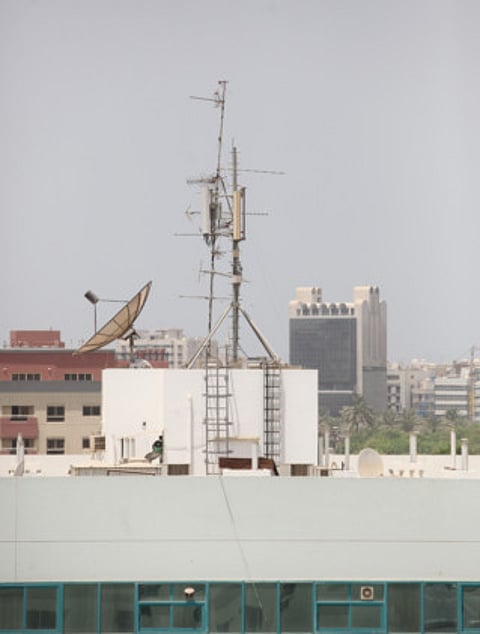Telecom mobile towers meet safe standards, says du
UAE telecom du says it meets national regulations that limit electromagnetic fields

Dubai: Following concerns by some residents that mobile phone towers in Bur Dubai and JLT are too close to their homes for comfort, du is assuring consumers that it only erects towers where national telecommunications policy allow.
The telecom’s assurances come after residents voiced health concerns about the location of three du mobile towers on the rooftop of their residential building in Bur Dubai.
The unease among expatriates comes on the heels of growing public concern and Indian government probes into the effects of people living within 50 metres of mobile phone towers in heavily congested neighbourhoods.
Asked to comment on safety issues in the UAE, du issued a statement to Gulf News noting that it is fully compliant with regulations issued by federal authorities.
“We take the health of our customers and fellow UAE residents very seriously, and are therefore fully compliant to a TRA policy that governs the placement of mobile sites in public areas, and which defines the minimum distance of exposure,” the statement read. “On top of this, we ensure that our mobile sites are in keeping with the best international practices and standards, strictly adhering to global standards of health and safety.”
The telecom noted that rooftop wireless towers are not exclusive to the UAE.
“The placement of mobile antennas on top of buildings is a common practice around the world, so this is not a phenomenon exclusive to Dubai. When the conditions are suitable, buildings are used to carry our mobile antennas to boost the signal for our customers in a particular area. There is no specific reason why the building in question is being used, other than its suitability and strategic location for the purpose. By removing this site, the mobile coverage in the surrounding area will be affected.”
In May 2011, the World Health Organisation (Who) issued a decision by the International Agency on Research on Cancer (IARC) that “classified radiofrequency electromagnetic fields as possibly carcinogenic to humans [Group 2B] based on an increased risk for glioma, a malignant type of brain cancer, associated with wireless phone use.”
The decision was arrived at after a group of 31 scientists from 14 countries weighed latest research on the dangers associated with transmitting wireless signals to more than five billion mobile phones in use around the world.
However, in its statement, du pointed out that the same Who/IARC decision also noted that there was “limited or inadequate” evidence of the risk of cancer” and that scientists await more study to make more detailed conclusions.
The telecom also referred to earlier comments by Who stating that: “Recent surveys have indicated that RF exposures from base stations and wireless technologies in publicly accessible areas [including schools and hospitals] are normally thousands of times below international standards”.
The regulations, meanwhile, are clearly spelled out in regulatory policy documentation by the Telecommunications Regulatory Authority (TRA) in the UAE.
According to the TRA policy on “Non-Ionizing Radiation Limits for Telecommunications Networks” dated June 21, 2010, and obtained by Gulf News, the TRA does audit base stations of telecoms to ensure that wireless transmission limits are not being exceeded.
“If there is any violation of these limits arising from the operation of a base station, the relevant base station will be subject to an immediate deactivation,” state the TRA regulations. “That base station will not be reactivated until such time as the relevant licensee can verify to the satisfaction of the TRA that the reactivation of the base station will not cause a breach” of international guidelines.
The TRA also heavily stresses in its regulations that telecoms when establishing new towers should avoid public areas.
“Licensees shall use their best endeavours to avoid establishing any telecommunications apparatus used for wireless transmissions [including any cellular or mobile base stations] next to buildings or places visited by the general public or large sections of the public such as schools, hospitals, and university campuses,” states the policy.
“Where such telecommunications apparatus are established next to such buildings, the relevant licensee shall use its best endeavours to minimise the radio frequency radiation intensity in these areas.”
Mitigation techniques to reduce frequency intensity at mobile towers can include, said the TRA, measures such as decreasing transmitter power, increasing the antenna height, or increasing the antenna gain.
The TRA provides a table limiting frequencies from 1 Hz to 300,000 MHz “for the calculation of minimum distances to antennas of transmission stations for compliance with the exposure limits for the population in general,” the policy states.
Sign up for the Daily Briefing
Get the latest news and updates straight to your inbox


